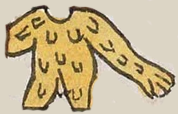ehuatl (Mdz40r)
This element was carved from the compound glyph for the place name, Ehuacalco. This component part, a male warrior's tunic called the (ehuatl) represents the Ehua- start to the name of the pueblo. The garment is yellow and textured.
Stephanie Wood
The term ehuatl) is often associated with animal hides, animal skins, leather, or even human skins. But this garment probably had a cotton fabric base with yellow feathers attached to it, hanging in rows. Sometimes its feathers were also red or blue (see the Florentine Codex, Book 8). This garment was apparently fairly impervious to spears, darts, arrows, and perhaps even European swords. Ross Hassig describes the ehuatl as not having sleeves or leggings, but this glyph shows both, which is likely a variation. [See: Hassig, Aztec Warfare (1995), p. 90.] John Pohl says the ehuatl had strips that hung down to protect the thighs. [See his book, Aztec Warrior, 2012, p. 21.] Other yellow feather-covered garments appear below. We are also including an animal hide that has not been made into a garment.
Stephanie Wood
c. 1541, but by 1553 at the latest
Stephanie Wood
armor, feathers, plumas, cotton, warriors, men, man, sleeves, leggings

ehua(tl), animal skin, leather, or hide, https://nahuatl.wired-humanities.org/content/ehuatl
hide or skin (animal or human)
la piel
Stephanie Wood
Codex Mendoza, folio 40 recto, https://digital.bodleian.ox.ac.uk/objects/2fea788e-2aa2-4f08-b6d9-648c00..., image 90 of 188.
The Bodleian Libraries, University of Oxford, hold the original manuscript, the MS. Arch. Selden. A. 1. This image is published here under the UK Creative Commons, “Attribution-NonCommercial-ShareAlike 3.0 License” (CC-BY-NC-SA 3.0).




